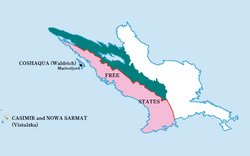Kahneska: Difference between revisions
Posadastan (talk | contribs) |
Posadastan (talk | contribs) |
||
| Line 122: | Line 122: | ||
===Forest Period=== | ===Forest Period=== | ||
The [[Forest period]] of Elia Borealis began around 200 CE, where {{wp|agriculture|agricultural}} practices became more widespread, and the nomadic and pastoralist ways of life began to decline. | |||
===Denvsoqua Period=== | ===Denvsoqua Period=== | ||
Revision as of 01:24, 2 September 2024
This article is incomplete because it is pending further input from participants, or it is a work-in-progress by one author. Please comment on this article's talk page to share your input, comments and questions. Note: To contribute to this article, you may need to seek help from the author(s) of this page. |
Federated States of Kahneska 6 official languages
| |||||||||||||
|---|---|---|---|---|---|---|---|---|---|---|---|---|---|
|
Flag | |||||||||||||
| Anthem: Morning Song (Teehahnahmah)
| |||||||||||||
 Location of Kahneska in Elia Borealis | |||||||||||||
| Capital | Ahtawenhne | ||||||||||||
| Largest city | Nokosvyi | ||||||||||||
| Official languages | Gawonihisdi Kanien'kéha Iyuha Ínts’o Goyogohó twayaʔ | ||||||||||||
| Recognised regional languages | Helmenska Hyacinthean Fallish Waldish Helmish | ||||||||||||
| Ethnic groups (2022) | 26.7% Ama 17.7% Kanonhwarón 13.9% Škaŋkála 11.2% Wazha'ze 8.3% Gweñskë 6.6% Nihsëh 14.3% Elian/Free Stater 1.3% Other | ||||||||||||
| Religion (2022) | 58.1% Gregorianism 13.6% No religion 25.6% Folk religion 2.7% Other | ||||||||||||
| Demonym(s) | Kahneskan | ||||||||||||
| Government | Federal directorial parliamentary republic | ||||||||||||
| Ama Edohi | |||||||||||||
| Tekonwí Hill | |||||||||||||
| Waŋblí Ayútepiwiŋ | |||||||||||||
| Legislature | Kahneskan Parliament | ||||||||||||
| History | |||||||||||||
| Area | |||||||||||||
• Total | 448,454.7 km2 (173,149.3 sq mi) | ||||||||||||
• Water (%) | 9.53 | ||||||||||||
| Population | |||||||||||||
• 2022 estimate | |||||||||||||
• Density | 35.76/km2 (92.6/sq mi) | ||||||||||||
| GDP (PPP) | 2022 estimate | ||||||||||||
• Total | |||||||||||||
• Per capita | |||||||||||||
| GDP (nominal) | 2022 estimate | ||||||||||||
• Total | |||||||||||||
• Per capita | |||||||||||||
| Gini (2022) | low | ||||||||||||
| HDI (2022) | very high | ||||||||||||
| Currency | Uwoyí (Ꞹ), BSG) | ||||||||||||
| Time zone | UTC+4 (Kahneska Standard Time, KST) | ||||||||||||
| Date format | dd-mm-yyyy | ||||||||||||
| Driving side | right | ||||||||||||
| Calling code | +99 | ||||||||||||
| Internet TLD | .kn | ||||||||||||
Kahneska, officially the Federated States of Kahneska, is a sovereign state in Elia Borealis. It is bordered by the Free States to the west, the Siskiyou to the southeast, and X to the east. It is hydrologically bordered to the north by the Glacian Ocean and to the northwest by the North Medan Ocean. With an estimated population of around 16 million people, it ranks as the second most populous nation in Elia Borealis and is the most ethno-linguistically diverse. Kahneska's multiethnic heritage includes a mixture of indigenous Elian peoples and Calesian settler populations.
The territory of modern-day Kahneska hosted what was essentially the core of the Elian civilization, which extended across Elia Borealis; until the 16th century, after the disastrous Catabole crisis and Calesian colonization significantly shrunk the amount of land ruled over by the indigenous Elian tribes. Early forms of confederation persisted amongst the inland regions, where they often resisted colonial powers, until the early 18th century, with a brief resurgence again in the latter part of the century before being annexed into the Grand Federation in 1790. In the aftermath of a civil conflict alongside many decades of indigenous resistance, the country in its current borders gained its independence in 1895, taking on its current form of government in 1899. Since then, it has had some level of instability and internal strife, including internal tribal struggles and issues with the settler populations that still inhabit the country.
Known as the "land of lakes and mountains", Kahneska's abundance of biologically significant and unique ecosystems also includes many endemic species and landscapes and contributes to tourism and mineral exports as some of the primary means of economic development. However, despite being rich in raw exports, an estimated 22% of the population lives in poverty, nearly double that of its neighbors. Other issues facing the country include gun crime, corruption, and civil instability.
TBD
History
Pre-History
Around 10,000 BCE, some of the first Homo sapiens began to migrate westwards along a land bridge between Galania and Elia Australis. This era was marked too by a period of heightened global glaciation, cooler temperatures, and lower sea levels. Upon settling in Elia Australis for a couple thousand years, early humans began migrating northwards again.
As a result of early migration northwards from Elia Australis, the earliest human habitation of Elia Borealis began to occur around 3,000 to 2,500 BCE. The presence of humans in the region is evidenced by the existence of skeletal remains and stone tools found in the region. In particular, agricultural practices, likely carried over from Elia Australis, like the cultivation of maize, squash, and beans were widespread; however, the majority of these cultures remained fairly nomadic or pastoralist in nature.
Forest Period
The Forest period of Elia Borealis began around 200 CE, where agricultural practices became more widespread, and the nomadic and pastoralist ways of life began to decline.

